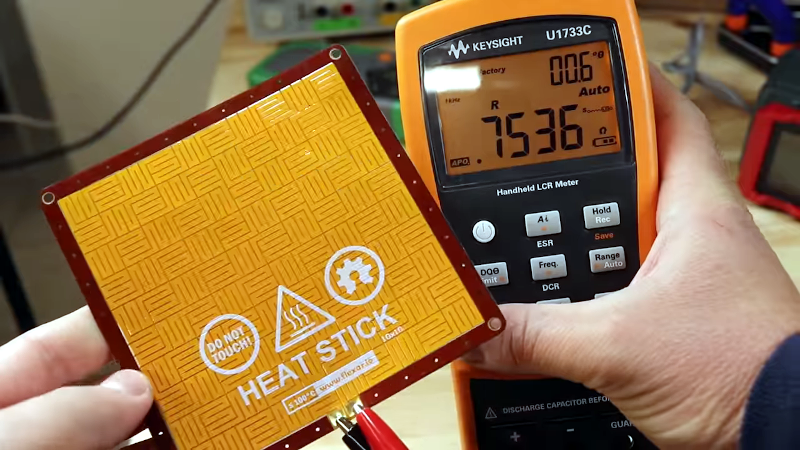[Carl] is always looking at making heater plates for PCB reflow and other applications. In his latest video, he shows how he is using thin flexible PCBs with adhesive backs as stickers that get hot. You can find gerber files and design files on GitHub.
You might think that this is a pretty simple thing to do with a flex PCB, but it turns out while the PCB might be flexible, the traces aren’t and so the typical long traces you see in a heater won’t allow the sticker to bend, which is a problem if you want to wrap it around, say, a coffee mug.
The answer was to create a pattern where the traces change direction frequently, and that’s what [Carl] did. He also talks about using stiffeners around the edges of the board.
The video shows quite a few tests that indicate the substrate discolor after a long time with high heat. The adhesive also tends to melt in those conditions. So the recommendation is to use them where you need lower temperatures for a long time or higher temperatures for a short duration. Of course, depending on your application, the color change may not matter as long as it doesn’t affect the long-term reliability.
What would you do with a flexible heated sticker? The self-warming mug is a no-brainer. A sticker to put on exposed pipes for a cold day comes to mind. A thin 3D printer bed heater or an irregular-shaped reptile habitat might be useful, too.
As long as you are putting patterns in any way, we wondered about making thermal digits on a sticker like this. It seems like every time we check in on [Carl] he’s heating up something.















With the right adhesive, sounds like it could find medical usage e.g. for pain relief?
I would say a flex PCB is too stiff to stick to the skin comfortably.
I think there’s hundreds of products for that purpose already. Mostly textile with velcro and stuff like that.
Regarding the sticker itself: The idea of course isn’t new. Self-adhesive PEI or silicon heat mats can be bough of many manufacturers. Just search for “self adhesive heating film”…
Anyway, if you need a custom heating film the above method would of course be king…
There’s a brand called kenovo or maybe keenovo on AliExpress that makes very nice, self-adhesive, custom silicone heating pads.
Silicon or silicone? There’s a huge difference.
I wonder, what is the resistance of the sheet? I didn’t watch the video, I’d be interested in voltage/ampere he uses to heat them. Anyone watched the video and got that info?
No video here either, but the image at the top of the article seems to imply the resistance is 0.7536 ohms.
Measured with a two-wire connection through alligator clips, no less!
Never mind the 0.1 milliohm claimed precision, I don’t think I’d have faith in the precision of even that first significant digit (0.1 ohm).
Thanks. Thats ~200W at 12V/16A. I was worried you’d need like 3V 60A. Still 16A is quite a lot.
200 W is a lot of power in 10 cm square. That’s 4x the power density of mine, and mine happily gets to 110 C in less than 10 minutes. 2 W/sq cm will make toast.
I wonder if it’s more like 5V, 7A. Though that’s not much — about the same power density as another printer of mine that only gets up to 60 C.
Sad that the info is probably locked up in a video.
12v/16A is well within the realm of the average dumpster-find ATX or server PSU. 12v/60A or more is quite common in the single-rail server units.
I don’t know the resistance but in the video he’s powering it at 4.6v @ 12A of which it seems to be using 9.3A at the time I could see the power supply.
Forgot to add it was running 120°C for 12 hours at those power levels, I’m not sure if he was regulating the heat by means of current or using a bang-bang type method.
This sounds like a job for Liquid Wire.
I could see this being implemented in cup holders in a car to keep your warm drinks warm. Be super easy to make it built-in on new vehicles
I’d be using this for germination pots or wraps. I live in the PNW and love growing peppers and tomatoes, but the warmth needed to grow great peppers far exceeds our *cough cough* Mediterranean climate production – at least for the next ten years, anyway.
Being able to wrap a heating panel on or around a 5-8 gallon planter in a lightbox with soil sensors would allow me to grow peppers at exactly the right temperature year-round regardless of the weather, and do so using nothing but power from the solar panels that run beautifully in our 45-50 degree winter weather.
Now just to find the perfect ceramic pot with space for the electronics.
Looks a lot like the Kapton heaters we have been using in Reprap for at least a decade. https://flic.kr/s/aHsjJ3VtUb
I guess maybe I am missing something.
Trinity even had some samples which were 100x100mm and I think they were something like 100w @12v. https://flic.kr/p/eggaaa
They do work well though. I have some which are from 2012/2013 which are still in use.
Adhesive engine block and car battery heaters are a lot cheaper per square cm than flex PCB. And available off the shelf in auto parts stores, tractor supplies, and walmarts in close proximity to just about everybody.